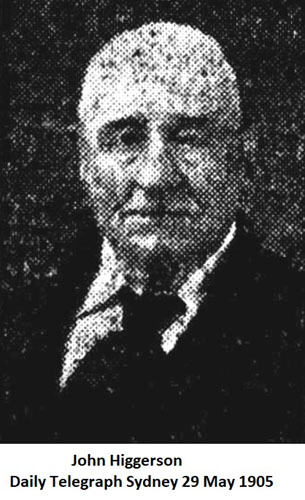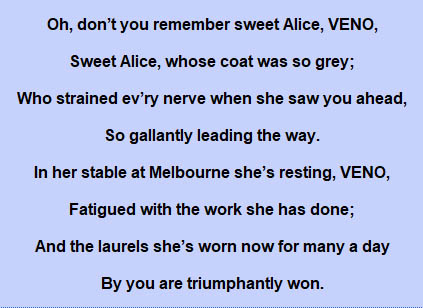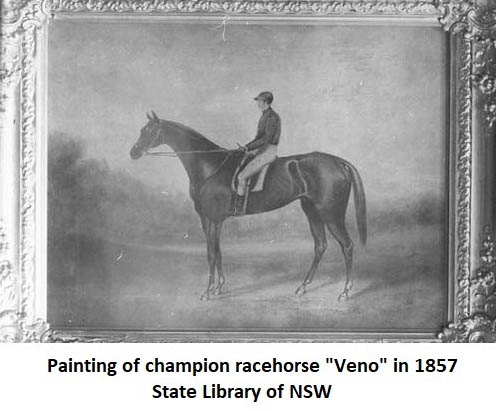

| Welcome | Database | Indexes | Copyright/Disclaimer | Login |
 Best
and Most Honest Jockey
Best
and Most Honest Jockey
John Higgerson,
with his second wife Ellen and some of his unmarried children moved from
Maryvale near Liverpool in the early 1880s to Heathcote, at that time known as
Bottle Forest. In 1885 government records1 show John Higgerson was a
landholder at Heathcote and on his 21 acres had two horses, 11 cattle and six
pigs. It is thought that this land was located immediately east of the road
bridge that spans the railway where John Paul Village nursing home stands today.
During the 1890s and possibly earlier, Higgerson was a ranger employed by the
trustees of the National Park2 and at that time Higgerson was already
in his seventies.
He had come to the district after an illustrious career as a jockey. From the
early 1830s Higgerson is said to have been under the watchful eye of Charles
Smith, a renowned horse breeder and trainer at Clifton.3
Higgerson became famous as a champion jockey and hero of colonial turf
racing. His mounts included the well-known racehorses
Jorrocks, Veno and Tarragon. For 35
years racing enthusiasts regarded him as a sure winner and he earned their
respect as an honest jockey. Although it was known he would never accept a bribe
to fix a race, Higgerson could work the situation to his advantage. After
winning a race at Windsor and in front of the crowd, he produced £50 from his
pocket and offered to return it to the stranger who had given it to him before
the race. Needless to say the stranger did not claim the money and Higgerson
gained £50.4 Near the end of his career in 1865, Higgerson was
presented with a riding whip by the Mayor of Sydney with the inscription ‘J.
Higgerson, the Best and Most Honest Jockey in the State of N.S.W.’5
Higgerson’s greatest claim to fame came during an intercolonial race between
rival towns of Sydney and Melbourne, a few years before the inaugural Melbourne
Cup. At Flemington on 3 October 1857, the Sydney champion,
Veno ridden by Higgerson was pitted
against the Melbourne champion, Alice
Hawthorn. Veno won the race and it
is said to have contributed to the establishment of the Australian Champion
Sweepstakes in 1859.6 Such was the impact of the event on colonial
society that there was a song written about the race and published in
Bell’s Life in Sydney and Sporting
Reviewer on 17 October 1857. The song contained four verses of which the
first verse appears here.


Higgerson retired from racing in 1867 after starting on
Tarragon in the Sydney Cup on the new
Randwick racecourse. Unfortunately he fell from his mount midway through the
race suffering from exhaustion. Higgerson’s racing days were at an end. However,
he did not retire from life and while still at Liverpool with his second wife
Ellen, John Higgerson fathered 12 more children.
John’s son, Frederick married Rosina Wellman in 1896 and later made their home
on the southern corner of Old Princes Highway and Cooper Street.7
This street was named after another early settler of the Engadine area, Francis
Seymour Cooper who married Frederick’s older half sister, Mary Jane. In 1906
Frank Cooper gave his occupation as miner for the electoral roll, though it is
said that with his brother Thomas, he operated a horse and cart service from the
area for passengers travelling to the city by train.8 In 1907 land on
the northern corner of Cooper Street and the Princes Highway was freehold land
owned by John Higgerson’s wife, Ellen Higgerson. Lot 97 on the corner of
Copeland and Numantia Roads and lot 105 on the Old Princes Highway just south of
Cooper Street were freehold lots belonging to John Higgerson. It has not been
determined if this refers to John Higgerson senior (he died intestate in 1905)
or his son John Higgerson.
Frederick and Mary Jane’s brother, Walter Bernard Higgerson, also lived on
Cooper Street after his return from active service in World War I. Walter
(Wally) enlisted on 20 June 1916. He left Australia with the 36th Battalion, 6th
Reinforcements and spent some time in England before heading to France almost a
year later. After six months in the field in both France and Belgium, Wally
became a target and received a gunshot wound that fractured his skull. He
returned to Australia in March 1918. Wally never married and died on 20 May
1955. His ashes were placed in the AIF Wall of Memories in Woronora Cemetery.
Although a number of newspaper reports of John Higgerson’s death and his
headstone state his age to be 95, Higgerson was 85 years old when he died. On 6
May 1905 Higgerson was on the verandah of his home with some of his family
and Henry Richard George Roberts. Henry Roberts, who later married Higgerson’s
grandaughter Alma Cooper, and one of Higgerson’s sons were making preparations
to go shooting. Roberts had loaded his gun and was locking it when it
unexpectedly exploded. The bullet wounded Higgerson severely and he was taken to
Sydney Hospital by train.9 Many thought Higgerson would survive the
ordeal and Frank Farnell, chairman of the National Park Trust, appealed to ‘all
true lovers of real and honest sport, as well as those who can admire a
blameless and spotless life, to contribute something towards a fund to comfort
the old fellow and his aged partner in their declining years’. Higgerson died on
25 May, 19 days after the accident. At the first race meeting at Rosehill
following Higgerson’s death, £20 was collected. The Australian Jockey Club
donated a further £25 from its funds.10
Higgerson was laid to rest in the Anglican section of Woronora Cemetery, grave
235-236 where about 250 mourners gathered to farewell the old-timer. The colours
that Higgerson wore when he rode Veno
and Tarragon were placed on the coffin. In November of the same year,
his son Frank died at the age of 36 and was buried with his father.
Although John Higgerson had passed away, his sons Frederick, Walter and Clement
continued to reside at Engadine as did their mother Ellen. A new home was built
for Ellen, thought to have been on land where Boys Town was later built.11
When Ellen died on 16 March 1923 she was buried with her husband and son.
In 1948 a new road which runs between Fairview Avenue and Stephen Road was made
in Engadine and named Higgerson Avenue in honour of John Higgerson. At
Heathcote, a short street runs from the Princes Highway into Rosebery Street and
is named Veno Street after Higgerson’s mount on which he won the intercolonial
match race in 1857.
Children of John Higgerson
Rebecca Elisabeth
1845-1857
Mary Jane
1849-1932 m. 1873 Francis Seymour
Cooper
Alfred Richmond
1851-1853
Joseph
1854-1920
m. 1. Catherine Blinman
m. 2. Theresa Buckley
Edward
1858-1858
Amelia Catherine
1859-
m. 1882 Jacob Hayes
Andrew Leslie
1864-1865
George Arthur
1866-1950 m. 1898 Hannah
Sarah Moon
Alfred
1868-1868
Frank
1869-1905
Emily Maud
1871-1872
Ruth Catherine
1872-
m. 1895 Frederick Nightingale
Frederick
1874-1955
m. 1896 Rosina Wellman
Clement Dean
1876-1936
m. 1910 Jessie Aileen Byrne
Henry Austin
1878-1952
m. 1901 Florence Black
Walter Bernard
1880-1955
Asenath Meriam
1881-
Albert Edward
1883-1885
Mildred Nelly
1885-
m. 1910 James McNee
Esther
1888-
m.1908 Stephen Kelly
SUE HEWITT
Click on the name
JOHN HIGGERSON (1820—1905) at the heading of
thIs story. You will be taken to the database entry for John Higgerson and his
family.
Endnotes:
2.
1894 electoral roll, District of Woronora, Sutherland division
3.
Some Ups and Downs of an Old Richmondite : Alfred Smith as chronicled by
Robert Farlow in the Windsor-Richmond
Gazette 1909-1910
4.
Parade Magazine September 1959
5.
Oral History Judith Riley
6.
They’re Racing! The complete story
of Australian racing, Penguin Books
1999
7.
ibid
8.
Engadine
1825-2001
compiled by Ron Seville for Lions Club of Engadine
9.
Coroner’s
inquest 1905 No.520
10.
SMH 26 May 1905; SMH 29 May 1905
11.
Oral history Phil Higgerson